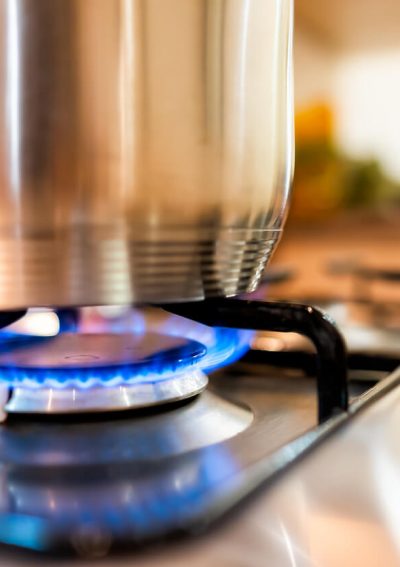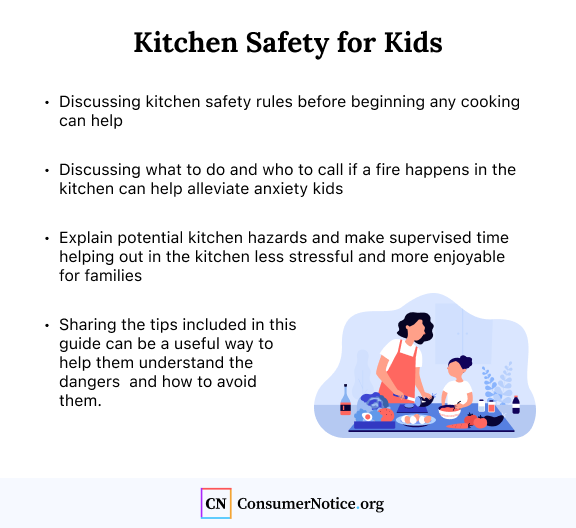Kitchen Safety
The kitchen is often where families come together to cook and spend time. Practicing home safety in the kitchen is essential to minimize unnecessary fire and injury risks, allowing families to enjoy their kitchens as a central gathering point.

According to the National Fire Protection Association (NFPA), 66% of kitchen fires start with the ignition of cooking materials or food. In the United States, 42% of all fires start in kitchens.
Cuts and lacerations from working with food account for a large portion of hand injury related emergency room visits. To increase kitchen safety, be sure everyone helping to prep and cook food follows some helpful basic rules.
Kitchen Safety Rules Before Cooking
Understanding the risks that are present in the kitchen and how to handle injuries or complications when they arise are key ingredients of kitchen safety. The following tips can help:
- Use Mitts or Gloves: Use properly insulated materials designed specifically to handle hot metals. Using thin or damp fabric can result in burns.
- Organize Your Stovetop: Turn all pot handles toward the back of the stovetop to avoid spills and prevent children from reaching for handles hanging over the edge. Additionally, pots and pans should be used from back to front on stovetops. Keeping cookware toward the back of the stove reduces the risk of spills and fire.
- Know Microwave Dos and Don’ts: Don’t put any form of metal in the microwave, including tinfoil. Do try to use microwave-safe cookware at all times, but avoid using melamine-based cookware in the microwave even if it’s labeled as “microwave safe.” The FDA recently recommended against this as it was found that melamine can slowly transfer to foods at higher temperatures.
- Stay Alert: Never operate kitchen equipment if sleepy, intoxicated or on medication that can cause dizziness or drowsiness. A lapse in focus can increase risks of injury or fire.
- Keep Stoves Clear: When cooking, clear the stovetop of any flammable materials. This includes oven mitts, wooden utensils, food packaging, towels or curtains. Even with an electric stove, hot surfaces and cookware present a fire hazard. Also keep stove interiors and stovetops clear of spilled food that can eventually smoke or catch fire.
- Learn Fire Preparedness - Knowing how to respond to different types of kitchen fires is important. Keep a class B dry chemical fire extinguisher and the lids to pots and pans nearby.
Make following these rules a top priority for the whole family, empowering children to grow their culinary skills safely. With the right tools and knowledge of how to properly use and maintain them, time in the kitchen can be fun.
Knife Safety
Knives are extremely dangerous when used improperly. An estimated 42% of hand injuries assessed in emergency rooms are the result of working with food and knives. Following a few simple rules can reduce the risk of cuts and lacerations.
Don’t leave knives in the sink, loose in drawers or exposed on counters. Unsecured or hidden knives can lead to accidental cuts. After a knife is used it should be kept in a knife block or holder. Make sure to clean knife blocks and holders to avoid a buildup of bacteria that can contaminate knives.

When cutting food, always use a stable surface, cut away from the body and make sure knives are sharp. A dull knife will require extra force to cut that can lead to a loss of control. If it is necessary to move from one place to another with a knife in hand, hold the blade downward and let others know you are coming through.
Poisoning
Aside from cuts, burns, fire risks and other harmful products, there are many ways to get sick from items located in the kitchen and the improper preparation of food. Food safety is extremely important, which is why it’s important to recognize bacteria and chemical risk factors while in the kitchen.
Bacteria grow on surfaces in the kitchen and can be present in undercooked or spoiled meat. Common household cleaners pose a risk to children in the kitchen and can cause illness if the cleaner gets in the food. Here are some common best practices to avoid poisoning:
- Wash your hands before handling food and after. If working with raw meat, wash your hands any time you go from the raw meat to another food item.
- Put perishable foods away right after use. Do not wait, as this can decrease the foods’ freshness.
- Wash fruits and vegetables in fresh water before eating. Make sure to only use water, not soap.
- Don’t put cooked food on the same plate, tray or cutting board as raw or ready to eat food to prevent cross contamination and the spread of bacteria.
- Clean messes as they happen, not days later. This will reduce bacteria spread in the kitchen.
- Follow safe use instructions and warning labels.
- If the container label, or the container itself, is not in good condition, do not buy or use the product inside.
When purchasing cleaning products, always select the least toxic option and never mix household cleaners. Any two different types of drain cleaner should never be mixed. Vinegar combinations with hydrogen peroxide, ammonia and bleach are also highly dangerous.
Bleach is also a cleaner to avoid combining with products such as rubbing alcohol and ammonia. If ever exposed to a toxic chemical or chemical mixture, rinse for 30 minutes for corrosive chemicals and 20 minutes for chemicals that are toxic if absorbed via the skin. For milder chemicals, rinse the affected area for five minutes.
If you aren’t sure what to do, call your local Poison Control Center using the national number: 1-800-222-1222
Kitchen Safety Rules While Cooking
Active cooking increases the risk of spills, burns, cuts and fire. The safety rules change when the kitchen becomes active. With so much to manage, make sure to be alert and attentive to what you are cooking.
No matter if you are simmering, baking or roasting food, check on it regularly. One person should always be present when food is cooking. This is especially true when frying, grilling, boiling or broiling food. To be as safe as possible, avoid putting hot dishes (glass) on wet or cold surfaces. Don’t use metal utensils on nonstick or Teflon pans. Don’t use cutting boards for fruits and vegetables if there was raw meat cut on it in the same cooking session.
Kitchen Safety for Kids
Child safety in the kitchen is, of course, a priority for families. Making sure to discuss kitchen safety rules before beginning any cooking can help. Sharing the tips included in this guide can be a useful way to help them understand the dangers and how to avoid them.
Fire safety for kids can help children feel safer. Discussing what to do and who to call if a fire happens in the kitchen can help alleviate anxiety kids may feel about potential kitchen hazards and make supervised time helping out in the kitchen less stressful and more enjoyable for families.

What to Wear While Cooking?
Cooking in the kitchen can involve hot oils and hot surfaces. Wearing the wrong clothing can leave your skin susceptible to burn injuries.
Avoid wearing long, baggy sleeves or tops without sleeves. Droopy clothing can get caught on pots and pans or catch fire if held over the stove. Wearing no sleeves at all poses the risk of direct burns to your skin.
The type of fabric can also impact kitchen safety. Don’t wear any flammable or synthetic materials, as they can melt onto your skin. To further increase kitchen safety, wear closed-toed shoes and remove all jewelry.
Cooking with Oil
Grease fires are one of the greatest risks when cooking in the kitchen. According to data from the United States Fire Administration, cooking fires lead to more injuries than other residential fires.
The worst type of cooking fires are grease fires. Learning how to safely cook with oil and what to do if a fire starts can greatly reduce the risk of injury and property damage.
- Always remain in the kitchen and stay alert when frying on the stovetop.
- Heat the oil slowly to the temperature you need for frying or sautéing.
- If you see smoke or the oil smells, turn off the burner and carefully remove the pan from the burner. Smoke is a sign that the oil is too hot.
- Add food gently to the pot or pan so the oil does not splatter.
- Always keep a lid nearby to put over the pan if a fire starts. Leave the lid on, turn off the burner and let it cool before trying to touch the pan.
- Water will make a cooking fire worse.
If the fire does not go out after putting a lid over it, consider using a Class B dry chemical fire extinguisher. Practice home safety, get out of the house and call 9-1-1 if the fire still doesn’t go out. Grease fires can evolve quickly and get out of hand if not dealt with immediately, so when in doubt call for emergency services to help.
Burned While Cooking
Burns are common in the kitchen, but according to Science Direct study , there is a lack of awareness around correct first aid remedies while cooking. In the study, 32% of respondents treated burns with nonscientific remedies alone or in combination, including honey, egg white, toothpaste, white flour, tomato paste, yogurt, tea, sliced potato, butter or ice.
According to Mayo Clinic, minor burns should only be treated with cool (not cold) running water or be covered with a cool, wet compress until the pain eases. If the burn is deep, appears charred, shows heavy patches of white, brown, black or is larger than three inches, it is a major burn. Immediate care should be sought if this is the case. Until further help arrives, major burns can still be covered with a cool, moist bandage or clean cloth.
10 Cited Research Articles
Consumernotice.org adheres to the highest ethical standards for content production and references only credible sources of information, including government reports, interviews with experts, highly regarded nonprofit organizations, peer-reviewed journals, court records and academic organizations. You can learn more about our dedication to relevance, accuracy and transparency by reading our editorial policy.
- Shaffer, Jennifer. (2021, Nov. 12). Top 10 Kitchen Safety Do’s and Don’ts. Retrieved from https://www.tasteofhome.com/article/kitchen-safety-tips/
- Grover, Sakshi. (2019, Feb. 14). Basic Kitchen Safety Tips for Kids and Adults. Retrieved from https://parenting.firstcry.com/articles/magazine-basic-kitchen-safety-tips-for-kids-and-adults/
- Mayo Clinic Staff. (2018, Jan. 30). Burns: First aid. Retrieved from https://www.mayoclinic.org/first-aid/first-aid-burns/basics/art-20056649
- National Fire Protection Association. (n.d.). Cooking. Retrieved from https://www.nfpa.org/Public-Education/Fire-causes-and-risks/Top-fire-causes/Cooking
- Cameron, Steffani. (2017, Feb 14). How To: Put Out a Grease Fire. Retrieved from https://www.bobvila.com/articles/how-to-put-out-a-grease-fire/
- Alomar, Mohammed. (2016, Jun). Knowledge, attitude, and belief regarding burn first aid among caregivers attending pediatric emergency medicine departments. Retrieved from https://www.sciencedirect.com/science/article/abs/pii/S0305417916300432?via%3Dihub
- Gavin, Mary. MD. (n.d.). Being Safe in the Kitchen. Retrieved from https://kidshealth.org/en/kids/safe-in-kitchen.html
- Lincoln County. (n.d.). How to Put Out a Grease Fire. Retrieved from https://www.lincolncounty.org/DocumentCenter/View/7740/How-to-Put-Out-a-Grease-Fire?bidId=
- StaySafe.org. (n.d.). A GUIDE TO SAFETY IN THE KITCHEN. Retrieved from https://staysafe.org/safety/kitchen/
- University of Rhode Island. (n.d.). Rules for Kitchen Safety. Retrieved from https://web.uri.edu/4h/files/Kitchen-Safety.pdf
Calling this number connects you with a Consumer Notice, LLC representative. We will direct you to one of our trusted legal partners for a free case review.
Consumer Notice, LLC's trusted legal partners support the organization's mission to keep people safe from dangerous drugs and medical devices. For more information, visit our partners page.
844-420-1914
